Spinach is a highly nutritious and delicious leafy green vegetable reasonably easy to grow in any home garden.
However, to ensure a continuous yield of this fresh, natural ‘protein,’ it’s crucial to know how to harvest spinach without killing the plant.
Luckily, using the right techniques, you can easily harvest spinach without killing and even prolong its harvesting season.
This article provides a comprehensive guide on harvesting spinach without damaging the plant. It’ll also cover some actionable pro tips for promoting regrowth and maintaining the awesome fresh flavor of the harvested spinach.
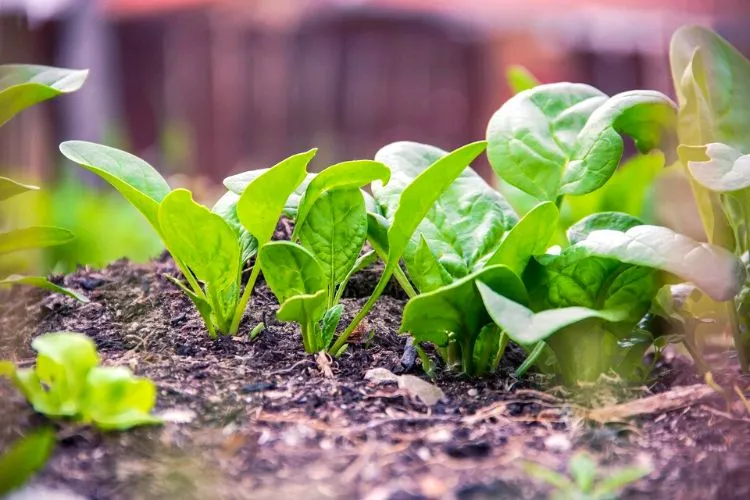
Table of Contents
Understanding spinach
Spinach is a highly versatile and nutritious vegetable that’s been a staple of diets worldwide for centuries. To make the most of this leafy power green, it’s essential to understand its different varieties, growth cycle, and the factors that affect its growth.
In this article section, we’ll explore these crucial spinach aspects to help you better understand and cultivate this popular, beneficial vegetable.
Spinach varieties
Spinach comes in a few different varieties, each with a unique texture and flavor profile. Choosing the right type of spinach can vastly enhance the taste of your dishes and even take your culinary experience to the next level.
In this section, we’ll explore some of the most common spinach varieties and provide tips on using them in cooking.
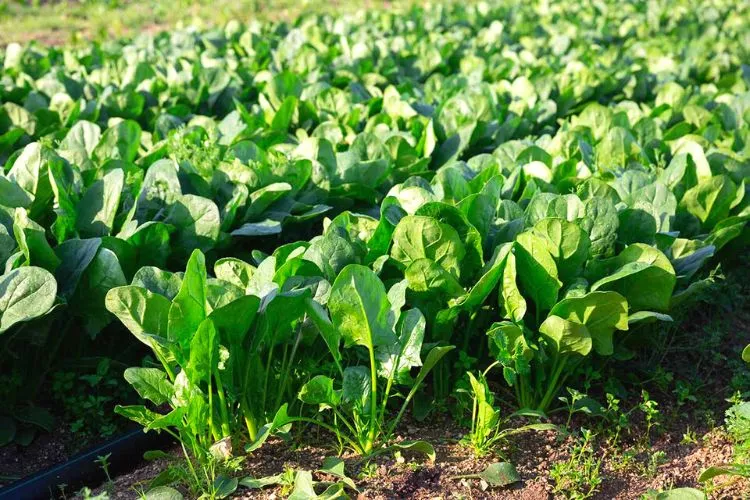
- Savoy spinach: Savoy spinach has crinkly, dark green leaves and a slightly bitter taste. It’s a good choice for soups, stews, and quiches.
- Flat-leaf spinach: This variety has smooth, broad leaves and a mild, sweet flavor. It’s perfect for salads, sandwiches, and smoothies.
- Semi-savoy spinach: The semi-savoy variety has leaves that are much less crinkly than savoy spinach but more textured than flat-leaf spinach. It has a delicate flavor and is ideal for sautéing, stir-frying, and as a staple vegetable in pasta dishes.
Spinach growth cycle
Understanding the growth cycle of spinach is crucial for cultivating a successful harvest. Here’s the thing… Spinach goes through several distinct phases of growth, from germination to flowering, each requiring specific conditions for optimal growth.
In this section, we’ll explore each of the different phases of spinach growth and provide tips on how to care for them during each stage.
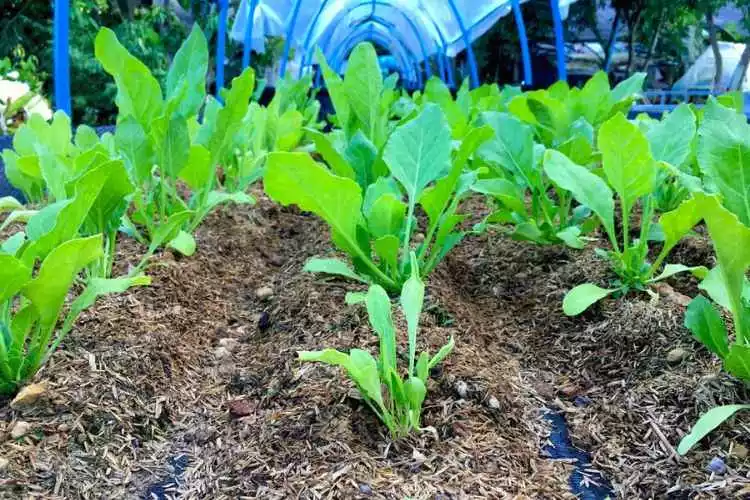
- Germination: Not much action happens during this first stage. The seed will sprout and develop into a small seedling.
- Vegetative growth: During this stage, the plant starts to grow a bit more rapidly and can start to produce a rosette of leaves.
- Bolting: Bolting is when the plant starts growing its flower stalk, and the leaves will become bitter.
- Flowering: This is the final stage of spinach growth when the plant produces flowers and goes to seed. Harvesting the spinach before this stage is important to prevent the leaves from becoming tough and almost inedible.
Factors affecting spinach growth
Spinach is a cool-weather crop that requires specific environmental conditions for optimal growth. Understanding the different factors that affect spinach growth, from temperature to nutrient availability, is essential for a successful harvest.
In this section, we’ll explore these factors in detail and provide tips on how to manage them to ensure healthy and robust spinach plants.
Let’s start with temperature…
- Temperature: Spinach grows best in cool temperatures that are maintained between 50°F and 70°F (10°C to 21°C). Any temperatures above this and for longer periods can cause the plant to bolt and produce bitter-tasting leaves.
- Moisture: Spinach needs a consistent source of moisture to grow properly. However, you need to be careful with the amounts, as overwatering can lead to root rot, whereas underwatering can cause the leaves to become bitter and tough.
- Soil pH: This type of plant prefers a slightly acidic soil pH that ranges between 6.0 and 7.0. Soil pH affects the plant’s ability to absorb nutrients by altering the chemical forms of the nutrients in the soil. In soils with high acidity (low pH), essential plant nutrients such as phosphorus, calcium, and magnesium become less available for absorption by plant roots.
- Similarly, in alkaline soils (high pH), nutrients such as iron, manganese, and zinc become less available. This requirement needs a lot of attention, especially in the plants’ early stages of growth and during soil preparation.
- Nutrient availability: Spinach requires certain nutrients, such as nitrogen, phosphorus, and potassium, to grow properly. A lack of nutrients can cause stunted growth and poor-quality leaves. When these nutrients aren’t available, the plant will struggle to grow roots that anchor, produce a stable stem and push out the lush green leaves that we know spinach produces.
How to Harvest spinach without Killing the Plant: Best Practices
Harvesting spinach is an essential part of gardening, but it can be tricky to do without damaging the plant. Harvesting spinach leaves at the right time and using proper techniques can ensure a continuous yield of fresh and tasty spinach throughout the growing season.
This section will provide best practices for learning how to harvest spinach without killing the plant. This includes timing the harvest to post-harvest care.
With these tips, you can enjoy a bountiful harvest of delicious, healthy spinach from your garden.
Timing of harvest
Timing is crucial when it comes to harvesting spinach. Picking those lush leaves at the right time ensures that the plant continues to encourage new growth and doesn’t go to seed too quickly.
In this section, we’ll provide tips on how to time the harvest of spinach leaves and prevent them from bolting. This will keep a continuous yield of fresh and healthy spinach for you to enjoy.
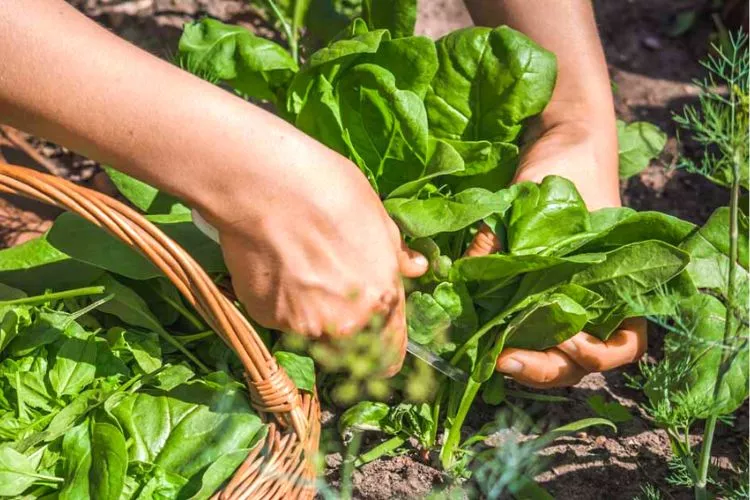
Harvesting mature leaves
The best method of harvesting is by only taking the mature leaves. This will promote and encourage regrowth as well as avoid bolting. A good sign to help know which leaves to cut is by checking out when the outer leaves are around 3-4 inches long and dark green.
Avoiding bolting
To prevent bolting, it’s essential to harvest the leaves before the plant begins to produce a flowering stalk. Bolting can cause the leaves to become tough and bitter, making them unpalatable.
By harvesting the spinach leaves at the right time, you’ll guarantee a long and continuous yield of fresh and tasty spinach.
Preparing for harvest
Proper preparation is essential for a successful spinach harvest. Before harvesting, it’s a good idea to ensure the plant is healthy and free from pests and diseases.
In this section, we’ll provide tips on preparing for harvesting spinach leaves, including cleaning the area around the plant and checking for pests and diseases.
We’ll also give examples of some of the most common pests and diseases that affect spinach and how to identify them.
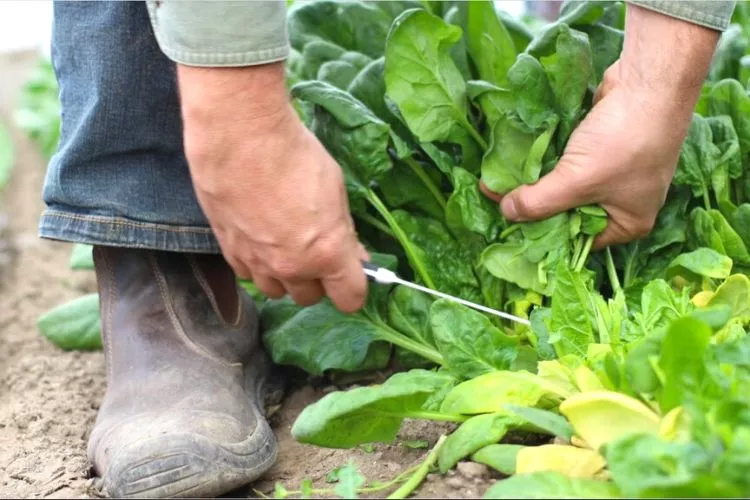
Cleaning the area around the plant
Before harvesting, remove any debris or dead leaves from around the plant. This will help prevent the spread of diseases and pests and ensure that the spinach leaves are clean and healthy upon harvest.
Checking for pests and diseases
Spinach is susceptible to several pests and diseases. These include aphids, leafminers, and downy mildew. To ensure a healthy harvest, checking the plant for any signs of pests or diseases before harvesting is essential.
Some signs of infestation include yellowing or curling leaves, discolored spots, and even powdery webbing. Having a good check amongst the leaves and around the stem is always advisable.
If you harvest an infested plant, it’s best to discard it as it’ll avoid transferring any nasties into your body and beyond.
How to harvest spinach?
Harvesting spinach properly is crucial for a continuous yield of fresh and healthy spinach leaves. In this section, we’ll provide step-by-step instructions on harvesting spinach leaves without damaging the plant.
We’ll also provide tips on the best tools to use for harvesting and how to identify the leaves ready for harvest.
Using scissors or a knife
To avoid damaging the plant when removing the leaves:
- Use a sterilized sharp pair of scissors, gardening shears, or a knife.
- Place the blades near the base of the stem and cut the leaf away from the plant.
- Try to make straight cuts, as this will prevent any onset of disease.
Cutting only the mature leaves
Try to harvest only the outer leaves of the spinach plant. Choose those that are dark green and around 3-4 inches long.
This promotes regrowth and ensures that the plant has the best chance of regenerating fresh spinach leaves.
Leaving small leaves in the center of the plant
When harvesting, be sure to keep the small, younger leaves in the center of the plant intact. This will give them the chance and time to mature and eventually become your lunch further down the track.
Best tools for harvesting spinach
Choosing the right tools for harvesting spinach is crucial for a successful harvest. Using the wrong tools can damage the plant and reduce its yield.
In this section, we’ll explore some of the best tools for harvesting spinach and provide tips on how to use them properly to avoid damaging the plant.
Scissors or knife
Sharp is key here. A sharp pair of scissors or a knife is essential for harvesting spinach leaves without damaging the plant. Place the blades near the base of the stem and cut the leaf away from the plant.
This will save any damage to the leaves and risk of disease exposure. Quite often, when a plant is pruned using a blunt tool, the damage it causes can become infected and essentially be an open invite for these diseases and pests.
Garden gloves
Wearing gloves can help protect your hands from any thorns or prickly hairs on the spinach plant. They may even be around other plants or soils that could cause harm.
Gloves can also help prevent the transfer of any harmful bacteria or fungi from your hands to the plant. Choose comfy and snug-fitting gloves allowing you to move your fingers easily.
Post-harvest care
Proper post-harvest care is crucial for keeping your spinach fresh and tasty after it has been harvested. In this section, we’ll provide tips on cleaning and storing your spinach leaves after harvesting to ensure their freshness and flavor.
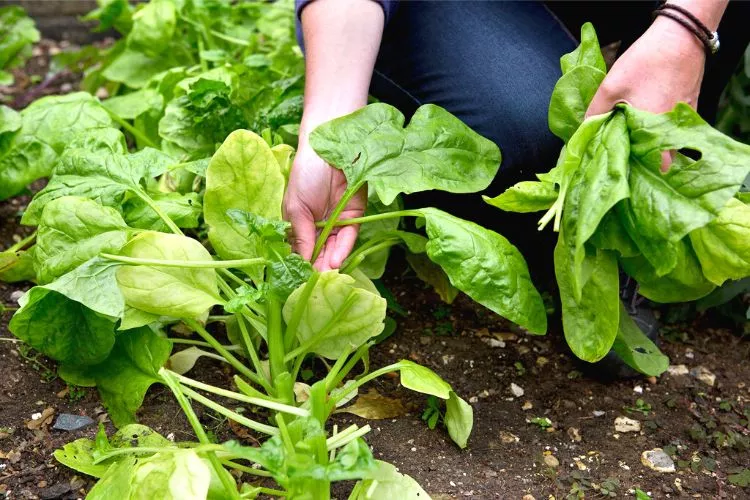
The following are the best practices for post-harvest care:
Cleaning the harvested spinach
To clean your harvested spinach leaves, you can follow along using these simple steps:
- Fill a bowl with cold water and add the spinach leaves.
- Give the leaves a bit of a gentle swish to remove any dirt or debris. And do be gentle because spinach can be quite sensitive.
- Remove the leaves from the water and rinse them under cold running water.
- Place the leaves in a colander and shake off any excess water. Alternatively, use a salad spinner.
Storing the spinach properly
To store your spinach leaves after harvesting, follow these simple steps:
- Place the spinach leaves in a clean, airtight container or plastic bag.
- Add some paper towel or clean cloth into the container or bag to absorb any excess moisture.
- Seal the container or bag tightly.
- Store the container or bag in the refrigerator at a temperature of around 32°F to 39°F (0°C to 4°C).
- Use the spinach within a week, as this is when the flavor is the most full and fresh.
Pro Tips for harvesting spinach
Harvesting spinach can be a rewarding and satisfying experience, but it requires some skills and techniques to do it properly.
This section will provide some pro tips for harvesting spinach to help you get the most out of your garden. From promoting regrowth to prolonging the harvesting season, these tips should help you grow and harvest healthy, delicious spinach leaves.
How to promote regrowth after harvesting?
Harvesting spinach leaves is a great way to enjoy a fresh, healthy snack or add flavor to your favorite dish.
However, to ensure a continuous supply of spinach throughout the growing season, it’s essential to promote regrowth after harvesting.
In this section, we’ll provide tips on promoting regrowth after harvesting spinach, including fertilizing the soil and watering regularly.
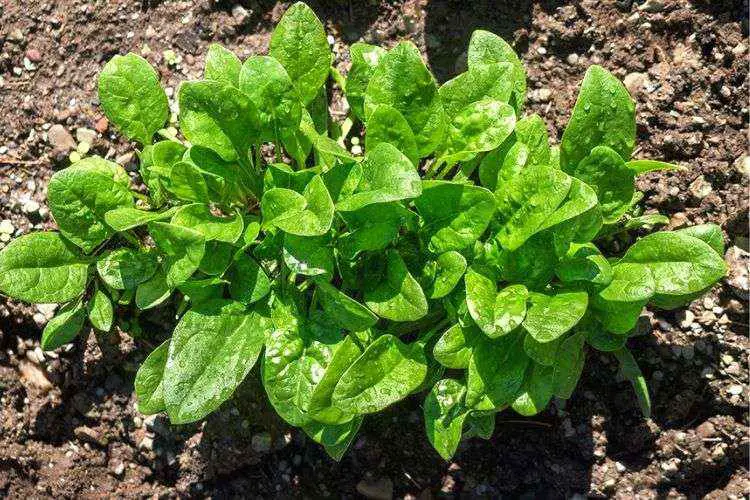
The following are the best practices for promoting regrowth after harvesting spinach:
- Fertilizing the soil: After harvesting, apply a balanced fertilizer, such as a 10-10-10 blend, to the soil around the spinach plant. This provides the nutrients needed to support new growth and helps plants produce plump, healthy leaves.
- Watering regularly: Spinach requires consistent moisture to promote regrowth, so watering them regularly is essential. Water the plant deeply once or twice a week, depending on the weather conditions and soil moisture. Go easy on the water, as too much of it will almost always lead to waterlogging and root rot.
How to avoid damage to the plant?
When it comes to harvesting the leaves, it’s a good idea to be a bit gentle so as not to spoil the plant and ensure a continuous supply of these wonderful healthy leaves. Damage to the plant can lead to stunted growth, disease, and reduced yields.
In this section, we’ll provide tips on how to avoid damaging the plant when harvesting spinach. They include avoiding crushing the plant tissue and not pulling or twisting the leaves.
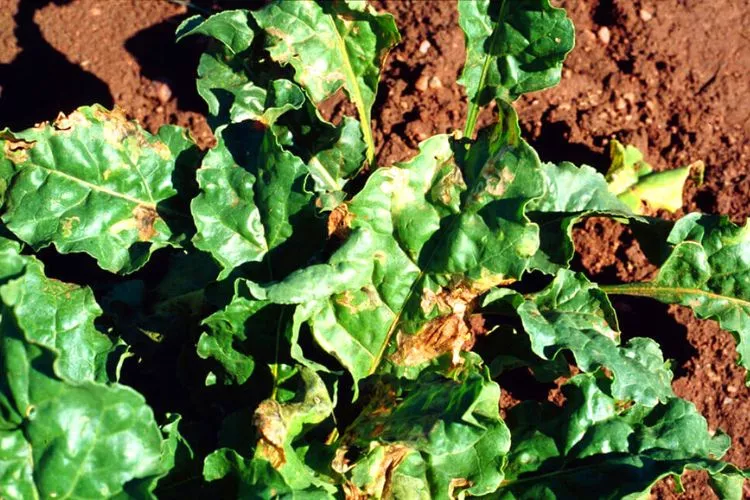
Let’s have a look at these practices in detail:
- Avoiding crushing the plant tissue: Crushing or bruising the plant tissue can cause irreversible damage to the plant. To avoid crushing the plant tissue, use scissors or a knife to cut the leaves away from the stem. This helps to minimize damage to the plant and promotes healthy regrowth. Try not to pull or rip the plant.
- Not pulling or twisting the leaves: Pulling or twisting the leaves can damage the plant and make it much tougher to regenerate. To avoid damaging the plant, simply use a gentle cutting motion to remove the leaves.
How to maintain the freshness and flavor of the harvested spinach?
After harvesting spinach leaves, it’s essential to maintain their freshness and flavor to ensure they taste their best when eaten. Proper storage techniques can help prolong spinach’s shelf life and maintain its flavor and nutritional value.
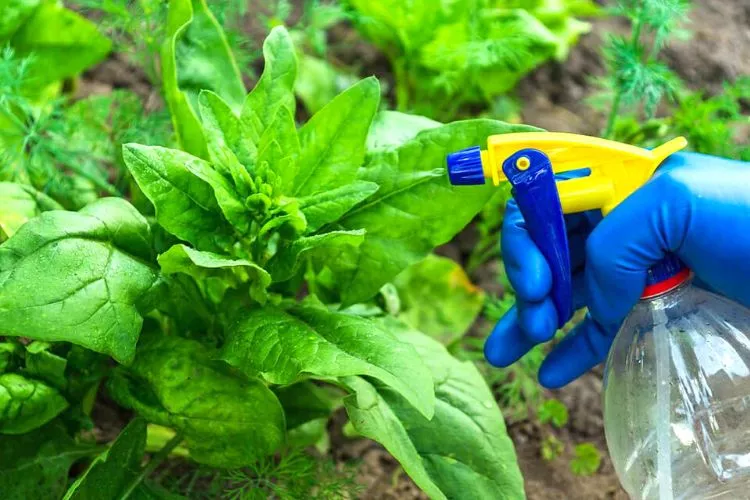
In this section, we’ll delve into how to maintain the freshness and flavor of the harvested spinach. This process includes refrigerating the spinach immediately and storing it in a breathable container.
The following are the best practices for maintaining the freshness and flavor of harvested spinach:
- Refrigerate the spinach immediately: Rinse the leaves and place them in a plastic bag after harvesting. Seal the bag and place it in the refrigerator immediately. Refrigerating the spinach leaves helps to slow down the decay process and assists in maintaining their freshness and nutritional value.
- Storing spinach in a breathable container: Spinach leaves need to breathe to maintain freshness and flavor. Store the spinach leaves in a breathable container, such as a perforated plastic or paper bag. Avoid using airtight containers, as they can trap moisture and lead to spoilage.
Final Pro Tips
- Harvest the outermost mature leaves first, and leave the smaller ones in the center to grow.
- Use sharp scissors to cut the spinach leaves, as dull tools can crush the plant tissue and damage the plant.
- Water the plants before harvesting to prevent the leaves from wilting.
- Harvest spinach in the morning or late afternoon when temperatures are cooler.
- Fertilize the spinach regularly to promote growth and ensure the leaves are nutrient-rich.
- To avoid soil-borne diseases, rotate your spinach with other crops each season.
Frequently Asked Questions (FAQs)
Can I harvest spinach leaves when they are small?
Yes, you can harvest small spinach leaves, but they are best harvested when mature. This is usually when they are around 3-4 inches long.
Can I harvest the entire plant at once?
Yes, you can harvest the entire plant at once. However, it’s recommended to harvest only the mature leaves, leaving the small leaves in the center of the plant for regrowth.
How often can I harvest spinach?
Spinach can be harvested as often as once a week, but waiting until the mature leaves are around 3-4 inches long before harvesting is best.
What are the signs that my spinach is ready for harvest?
When the spinach leaves are dark green and mature, they are ready for harvest. The outer leaves should be around 3-4 inches long.
Can I harvest spinach after it starts to bolt?
Yes, you can still harvest spinach leaves after the plant starts to bolt, but the leaves may become bitter. Harvesting the leaves before the plant bolts for the best flavor is best.
Conclusion:
Knowing how to harvest spinach without killing the plant is important for maintaining a healthy supply of fresh leaves and ensuring the plant’s regrowth and longevity.
By following the best practices outlined in this guide, you can prolong the harvesting season, maintain the freshness and flavor of the harvested spinach, and avoid damaging the plant.
We hope this guide has helped provide useful tips and techniques for harvesting spinach. Check our website for more similar topics, and stay tuned for more informative guides.
Thank you for reading!


